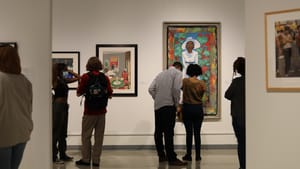Stay in the Loop
BSR publishes on a weekly schedule, with an email newsletter every Wednesday and Thursday morning. There’s no paywall, and subscribing is always free.
Quintessential American stories on loan from Bank of America
AAMP presents Vision & Spirit: African American Art

"We been through so much. It don't make no sense," I overheard a fellow museum-goer tell his family on a recent visit to the African American Museum in Philadelphia (AAMP). I was there to view two current exhibits: Vision & Spirit: African American Art | Works from the Bank of America Collection and Black Healthcare Studies.
The speaker, a middle-aged Black man with his family enjoying an afternoon at the museum, was simply repeating a sentiment that has been heard from church pulpits, around dining room tables, at family reunions, and during HBCU homecomings throughout the ages: that the (hi)story of Black people in the United States would be the makings of the most absurd fiction if it were not actually true. And yet, it is one of the quintessential American stories, one that involves and implicates all of us because it continues to unfold in real time while we struggle through the sensemaking.
Resilience
Upon ascending the ramp to the third and fourth floors of AAMP, the first images one sees are striking, historic black-and-white photos of civil-rights marchers and protestors, musicians, politicians, and public figures. These rare works, all by legends who have mastered capturing the Black experience from the mundane to the magnificent, like Ernest C. Withers, Carrie Mae Weems, and Roy DeCarava, comprise the first two of three themed sections of Vision & Spirit.
The first section is called “Resilience” and poses the question, “How might we recognize resilience in someone else, since it is most often a hidden characteristic?” What cannot be hidden is the well of fortitude and pride of a people, whose every breath is an act of resistance and survival. Two rare daguerreotype and tintype photographic portraits of Black women dating from the 1840s and 1870s sit in a small glass display in the middle of the floor. They could easily be overlooked or missed, but these maternal figures serve as anchors, as some of those under their watch struggle through exhaustion (as in Earlie Hudnall Jr.’s Sleeping Boy), or merely exist while relating to everyday objects like hair barrettes and playing cards (as in the crayon and found-object series by Whitfield Lovell).
The Journey
The repetition of black-and-white imagery initially obscures the transition between “Resilience” and the next section, “The Journey,” but upon closer observation, the focus shifts from the anonymous to the eminent. “The Journey” signifies the upward mobility and shift from surviving to thriving in Black communities. Prominently featured are black-and-white portraits of celebrities at work or in motion, like a sparring Muhammad Ali in mid-punch (Gordon Parks) and Duke Ellington smoking while playing the piano (Chuck Stewart).
“The Journey” also begins the integration of a wider spectrum of color and mediums. Romare Bearden’s screen-print Black Odyssey series, an interpretation of Homer’s classic that plays into the theme of the movement of Black people, inserts an exciting jolt of graphic animation and intense concentration of the colors blue, red, and green to wake up the palette from all the previous grayscale and black and white. Faith Ringgold’s quilted piece, Coming to Jones Road #3, Aunt Emmy, one of a series that collectively tells the story of a Black family’s escape to a rural oasis, infuses rich texture.
Black Healthcare Studies
I found “The Journey" to be the section most in conversation with AAMP’s other current special exhibit, Black Healthcare Studies. Located in the museum auditorium on the lower level, this creatively explores the systemic challenges Black people have historically faced in entering and inhabiting the medical profession. Co-curated by local med student Janita Matoke and featuring the digital collage and mixed-media work of artist Doriana Diaz, Black Healthcare Studies juxtaposes black-and-white archival images of Black healthcare workers with colorful and imaginative Afrofuturistic backgrounds and settings, giving a quality of timelessness even in its allusion to time travel.
New Dimensions
Back up on the fourth floor is Vision & Spirit’s final section, “New Dimensions,” which encapsulates the more conceptual and abstract pieces of the exhibit. There is so much to take in within this smaller space that I started to feel lightheaded. It was like an art high. On one wall, Betye Saar and Chelle Barbour collages deconstructing Black femininity and beauty hang side-by-side. On another wall is the triptych Blowing by Sam Gilliam (who passed last June), in which his canvases, saturated with vibrant hues of paint, are transformed into sculpture by removing the wood frames and allowing the fabric to create exquisite movement and shape. Then there is the full wall of Lorna Simpson photos zoomed in on her subjects’ hands. Each title is some seemingly random word or phrase not obviously related to the attached image. Is it a poem, some cryptic message, or a secret third thing?

Financial models of art?
Bank of America has loaned AAMP these pieces from its collection for free as part of its Art in our Communities program, and provided additional support for educational programming. AAMP assistant curator Zindzi Harley praises this “extensive” partnership, a project of several years: “We’re very grateful to be working with them, and their philanthropy just ranges from so many different aspects.”
According to the Art in our Communities site, Vision & Spirit is one of 13 exhibitions Bank of America has available for loan to nonprofits and galleries. Notably, only one other listed exhibition is centered around race or nationality: Luces y Sombras: Images from Mexico. Bank of America has also recently announced the Community Affordable Loan Solution, an effort to increase home ownership specifically targeting majority Black and Hispanic neighborhoods (according to census data). Coincidence?
A financial institution’s model is to hold (or hoard, depending on perspective) resources, whether it’s a liquid asset like cash or a physical asset like art, and selectively redistribute or create access to those assets. Should we consider these on-loan exhibitions as corporate generosity, or are they just another way to leverage the bank’s assets and support its own bottom line? Or perhaps a secret third thing, like contrition for complicity in past discrimination towards these same populations?
Whatever the motivation, it does not negate the fact that this is a spectacular collection of work of the highest caliber, which institutions like AAMP and their public should be able to access, but often cannot, because of systemic barriers like ownership. And no matter how hard they try or how much they’ve been through, that still don’t make no sense.
What, When, Where
Vision & Spirit: African American Art | Works from the Bank of America Collection (through February 11, 2023) and Black Healthcare Studies (through December 11, 2022). $10-$14. African American Museum in Philadelphia, 701 Arch Street, Philadelphia. (215) 574-0380 or aampmuseum.org.
Accessibility
The museum’s Covid-19 policy limits the available time slots for visits per day. Guests are required to mask and social distance.
All galleries are wheelchair-accessible.
Sign up for our newsletter
All of the week's new articles, all in one place. Sign up for the free weekly BSR newsletters, and don't miss a conversation.

 Hanae Mason
Hanae Mason